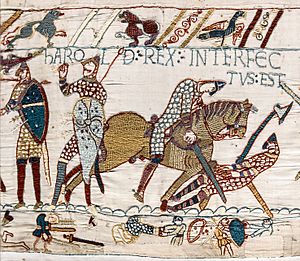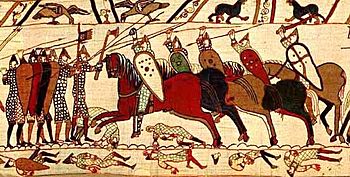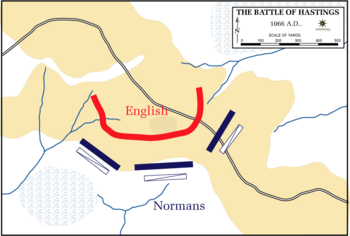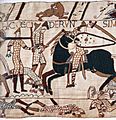Battle of Hastings facts for kids
Quick facts for kids Battle of Hastings |
|||||||
|---|---|---|---|---|---|---|---|
| Part of the Norman conquest of England | |||||||
 Harold Rex Interfectus Est: "King Harold is killed." Scene from the Bayeux Tapestry depicting the Battle of Hastings and the death of Harold |
|||||||
|
|||||||
| Belligerents | |||||||
| Normans | Anglo-Saxon England | ||||||
| Commanders and leaders | |||||||
| William of Normandy Alan the Red William FitzOsbern Eustace II, Count of Boulogne |
Harold Godwinson † Gyrth Godwinson † Leofwine Godwinson † |
||||||
| Strength | |||||||
| Unknown, estimates range from 7,000 to 12,000 | Unknown, estimates range from 5,000 to 13,000 | ||||||

The Battle of Hastings (October 14, 1066) was a battle between the Anglo-Saxon English and an invading Norman army. The battle lasted one day and ended in the death of the Anglo-Saxon (English) king and a decisive victory for the Normans. William, the Duke of Normandy, was crowned as King William I of England 10 weeks later. The Norman conquest was a major turning point in England's history.
Contents
Background
In 1002, King Ethelred of England married Emma (of France), the sister of Richard II, Duke of Normandy. The alliance formed by this marriage affected both countries. When King Canute, a Viking king of England, France, and part of Scandanavia, came to the throne of England fourteen years later in 1016, he took Queen Emma of Normandy, the English King Ethelred's wife, as his wife. (King Ethelred had recently died in a battle to defend England.) Emma's two sons from her former marriage to Ethelred fled to Normandy for their safety. Edward the Confessor, the older son, stayed in Normandy for many years at the court of the dukes. The last duke who protected him there was his cousin Duke William, who was later known by the names William the Conqueror and King William I. Edward (son of Ethelred and Emma) became king of England in 1042. In 1052, King Edward, who was childless, made William his heir. In 1065, Harold Godwinson, the Earl of Wessex and one of the possible heirs to Edward's throne, was in Normandy. While he was there, he promised Duke William he would support him as the successor to the English throne after Edward.
Three men thought that they had the right to the throne:
- William, the Duke of Normandy, to whom Edward promised the throne;
- Harold Godwinson, Earl of Wessex; and
- King Harald Hardrada of Norway, who believed that the throne of England should once again be ruled by a Viking king.
On January 5, 1066, King Edward died. Harold Godwinson, who had promised to support Duke William as the next king of England, did not respect his oath to William. The next day, the day of the funeral, Harold Godwinson was crowned king of England. The story was that on his deathbed, King Edward had changed his mind and promised Harold the throne. Harold was not royalty and had no legal right on the throne.
Prelude
When Duke William of Normandy heard the news that Harold Godwinson had become king, he reacted quickly. He called a meeting of his greatest men. William made plans to gather a large army from all over France. Because he was infuencial and wealthy, he could start a large campaign against Harold. William's first task was to build a fleet of ships to carry his army across the English Channel. Next, he started gathering an army. His friendship with Brittany, France, and Flanders meant he did not have to rely only on his army. He hired and paid soldiers from many parts of Europe. William asked for and got the support of the pope, who gave him a banner to carry into battle.
King Harald Hardrada of Norway had also heard that King Edward had died. He and Duke William were planning their separate invasions of England at the same time. King Harold Godwinson of England knew both would be coming for his throne and prepared for war. Harald of Norway reached England before William did.
William may have had as many as 1,000 ships in his invasion fleet. They had favorable winds when they left Normandy on the night of September 27, 1066. William's ship, the Mora, was a gift from his wife, Matilda. It led the fleet to the landing at Pevensey the next morning. As soon as he landed, William got news of King Harold's victory over the Norwegian King Harald at Stamford Bridge in the north of England. English King Harold had successfully defended against Norwegian King Harald but also received news that William had landed at Pevensey. This meant that he had to move south as quickly as he could. King Harold rested at London for a few days before taking his army south to meet William and his French forces.
The battle
While Harold Godwinson had more soldiers, they were tired from the march from London. King Harold's army took up a position on an east-west ridge north of Hastings called Senlac Hill. They found the Norman army marching up the valley in front of them. William formed his lines at the base of the hill facing the shield wall of the English. He sent his archers halfway up the slope to attack the English and sent his mounted knights (knights who rode on horses) to the left and right to find any weak spots. At first, William's knights tried to break through the shield wall with the weight of their horses. This plan did not work, however, because they were attacking uphill and could not gain any speed. Harold's front line simply stood fast and was able to fend off any attacks.
When William's army began to fall back with rumors of his death, Duke William removed his helmet so his men could see he was still alive. When William saw that many of Harold's men were following his knights back down the hill, he used a trick he had learned years before. He turned suddenly and charged the oncoming English foot soldiers, who had no chance against mounted knights. This tactic worked at least two more times during the battle and made Harold's shield wall weaker.
Next, William used something new. Where his attacks by knights and soldiers had been separate movements before, he now used them together. Where his archers had not succeeded against the shield wall, he commanded them to shoot high into the air so the arrows came down on top of the English. This may be where King Harold was killed by an arrow through his eye. The shield wall finally broke, and the Normans were on top of the English. By nightfall, the English were either dead on the field or being hunted down by William's men. William called his men back and they spent the night camped on the battlefield.
Aftermath
The battle was won, but the English still had smaller armies that had not joined King Harold at Hastings. They had lost their king but were still trying to reorganize. William rested his army for five days before moving toward London. His march took him through several towns that he either captured or destroyed. When William reached London, the English resisted for a short time but in the end, surrendered.
The Battle of Hastings was a major turning point in English history. William's claim to the throne was strong, and he was able to back it up with force. On Christmas Day in 1066, William was crowned King of England.
The battle is pictured on a series of panels called the Bayeux Tapestry. William's victory at Hastings gave him the nickname he has been known by ever since: "William the Conqueror."
Interesting facts about the Battle of Hastings
- The Battle of Hastings took place about seven miles away from Hastings in a town that is now named "Battle."
- The first person killed in battle was William's jester, Taillefer.
- The battle lasted from 9:00 a.m. until dusk.
- The Normans used "feigned flight," a trick that made it look like they were retreating. This opened the English up to attack because they were chasing the Normans.
- William stayed true to his promise to build an Abbey after he won the battle.
- William spoke only French, so after he was crowned king, he changed the language of the court to French. This introduced hundreds of French words into the English language.
Images for kids
-
The location of the Battle of Stamford Bridge
-
Norman knights and archers at the Battle of Hastings, as depicted in the Bayeux Tapestry
-
View of the battlefield looking towards Senlac Hill
-
Stone marking the spot of the high altar at Battle Abbey, where Harold died
-
Reenactment in front of Battle Abbey
See also
 In Spanish: Batalla de Hastings para niños
In Spanish: Batalla de Hastings para niños












